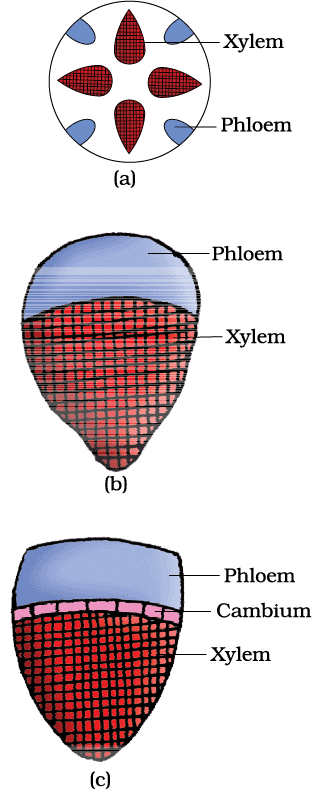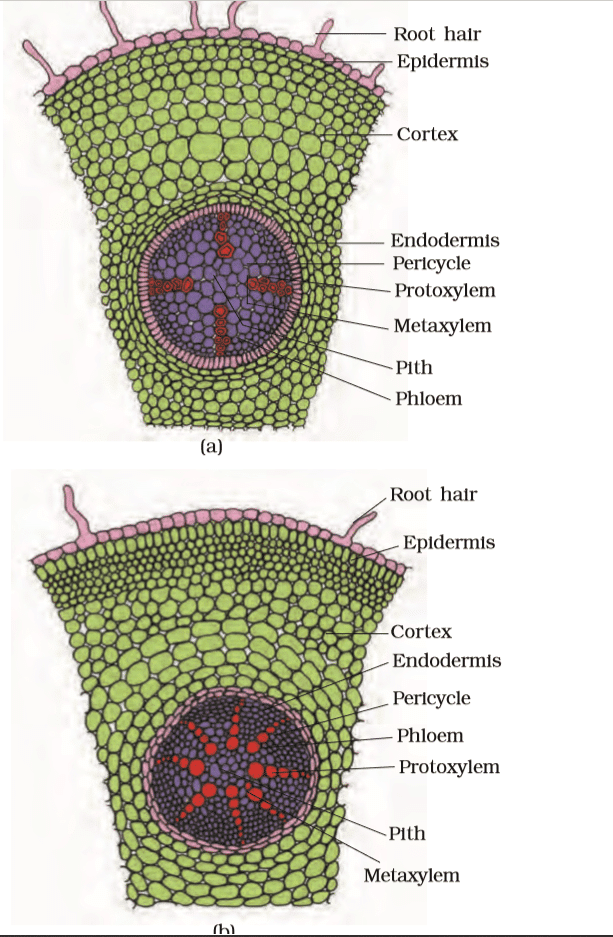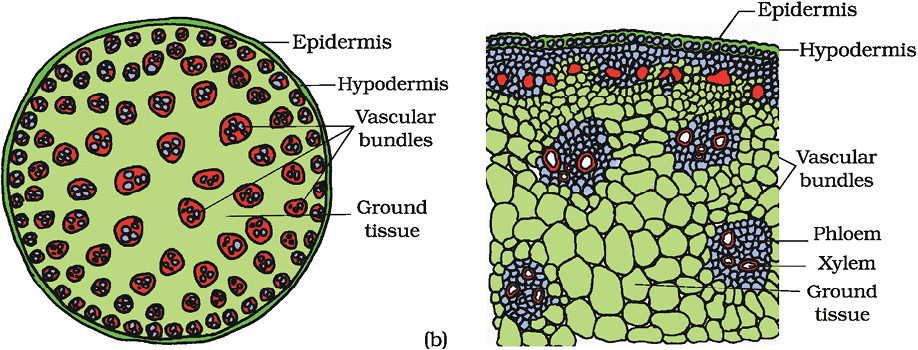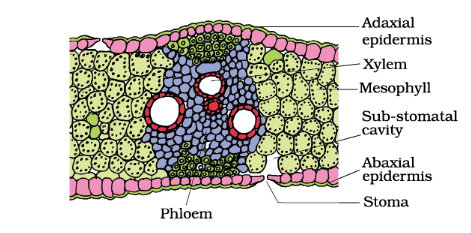Anatomy of Flowering Plants Chapter Notes | Biology Class 11 - NEET PDF Download
| Table of contents |

|
| What is Anatomy? |

|
| The Tissue System |

|
| Anatomy of Dicotyledonous & Monocotyledonous Plants |

|
| Plant Tissue (Only in NEET) |

|
What is Anatomy?
Plants and animals exhibit both similarities and differences in their external and internal structures. The study of a plant's internal structure is known as anatomy.
- Plants are made up of cells, which are the basic unit of life.
- These cells are organized into tissues, and different types of tissues are grouped together to form organs.
- Within a plant, different organs can have distinct internal structures.
- In flowering plants (angiosperms), there are two main groups: monocots and dicots, which differ in their internal anatomy.
- Moreover, the internal structures of plants show adaptations that help them thrive in various environments.

The Tissue System
- Tissues in plants can be categorized based on the types of cells present.
- Tissues in plants can also vary based on their location in the plant body, which affects their structure and function.
- There are three types of tissue systems based on their structure and location: the epidermal tissue system, the ground or fundamental tissue system, and the vascular or conducting tissue system.

1. Epidermal Tissue System

(i) Structure of Epidermis
- Forms the outermost covering of the plant body.
- Comprises of epidermal cells, stomata, and epidermal appendages such as trichomes and hairs.
- Epidermis is the outermost layer of the primary plant body.
- Made up of elongated, compactly arranged cells that form a continuous layer.
- Usually single-layered.
- Epidermal cells are parenchymatous with a small amount of cytoplasm lining the cell wall and a large vacuole.
(ii) Role of Cuticle
- The outside of the epidermis is often covered with a waxy thick layer called the cuticle.
- Cuticle prevents the loss of water by reducing water loss through the epidermis.
- Cuticle is absent in roots.
(iii) Stomata and Their Function
- Stomata are structures present in the epidermis of leaves.
- Stomata regulate the process of transpiration and gaseous exchange.
- Each stoma is composed of two bean-shaped cells known as guard cells which enclose stomatal pore.
- In grasses, the guard cells are dumb-bell shaped.
- The outer walls of guard cells (away from the stomatal pore) are thin, and the inner walls (towards the stomatal pore) are highly thickened.
- Guard cells possess chloroplasts and regulate the opening and closing of stomata.
- Subsidiary cells: Some epidermal cells near the guard cells become specialized in shape and size and are known as subsidiary cells.
- The stomatal aperture, guard cells, and subsidiary cells together are called the stomatal apparatus.
 Diagrammatic representation: (a) stomata with bean-shaped guard cells (b) stomata with dumb-bell shaped guard cell
Diagrammatic representation: (a) stomata with bean-shaped guard cells (b) stomata with dumb-bell shaped guard cell
(iv) Epidermal Hairs
- Root hairs: Unicellular elongations of epidermal cells in roots that help absorb water and minerals from the soil.
- Stem hairs (Trichomes): Epidermal hairs on stems that are usually multicellular.
- Types of trichomes: Branched or unbranched, soft or stiff, and may even be secretory.
- Function of trichomes: Help in preventing water loss due to transpiration in shoot system.
2. The Ground Tissue System

- All tissues except epidermis and vascular bundles constitute the ground tissue.
- It consists of simple tissues such as parenchyma, collenchyma and sclerenchyma.
- Parenchymatous cells are usually present in cortex, pericycle, pith and medullary rays, in the primary stems and roots.
- In leaves, the ground tissue consists of thin-walled chloroplast containing cells and is called mesophyll.
3. The Vascular Tissue System
The vascular system consists of complex tissues, the phloem and the xylem and make vascular bundle. The vascular bundles form the conducting tissue and translocate water, minerals and food material.
- Open vascular bundle: In dicotyledonous stems, cambium is present between phloem and xylem. Cambium forms secondary xylem and secondary phloem during secondary growth i.e. increase in girth.
- Close vascular bundle: cambium is absent between xylem and phloem in monocot stem.
- Radial vascular bundle: When xylem and phloem within a vascular bundle are arranged in an alternate manner on different radii. E.g. roots.
- Conjoint Type: The xylem and phloem are situated at the same radius of vascular bundles’. e.g. leaves and stem. The conjoint vascular bundles usually have the phloem located only on the outer side of xylem.
 Various types of vascular bundles : (a) radial (b) conjoint closed (c) conjoint open
Various types of vascular bundles : (a) radial (b) conjoint closed (c) conjoint open
Anatomy of Dicotyledonous & Monocotyledonous Plants
To gain a clearer understanding of how tissues are organized in roots, stems, and leaves, it is helpful to examine cross-sections of the mature regions of these organs.
1. Dicotyledonous Root
(i) Epiblema - The Outermost Layer
- Epiblema is the outermost layer of the root.
- Many of the epiblema cells protrude as root hairs, which help in the absorption of water and minerals from the soil.
(ii) Cortex - Several Layers of Parenchyma Cells
- The cortex is located below the epiblema and consists of several layers of thin-walled parenchyma cells with intercellular spaces.
- Parenchyma cells in the cortex are responsible for the storage and transportation of food materials.
(iii) Endodermis - Innermost Layer of Cortex
- The endodermis is the innermost layer of the cortex.
- It is composed of a single layer of barrel-shaped cells without any intercellular spaces.
- The tangential and radial walls of the endodermal cells have a deposition of water-impermeable, waxy material called suberin, in the form of Casparian strips.
- Casparian strips help in regulating the entry of water and minerals into the vascular tissue.
(iv) Pericycle - Thick-Walled Parenchyma Cells
- Pericycle is located next to the endodermis.
- It comprises a few layers of thick-walled parenchymatous cells.
- Pericycle is responsible for the initiation of lateral roots and vascular cambium during secondary growth.
(v) Pith - Small or Inconspicuous
- Pith is located towards the center of the root.
- It is usually small or inconspicuous and contains parenchymatous cells.
- Pith stores food materials and provides mechanical support to the root.
(vi) Conjunctive Tissue - Parenchymatous Cells between Xylem and Phloem
- Conjunctive tissue is located between the xylem and phloem in the root.
- Parenchymatous cells in the conjunctive tissue provide mechanical support and help in food transportation.
(vii) Vascular Bundles - Xylem and Phloem Patches
- There are usually two to four patches of xylem and phloem in the root.
- Xylem conducts water and minerals upwards, while phloem transports food materials in both upward and downward directions.
- Later, a ring of cambium develops between the xylem and phloem, which is responsible for secondary growth.
(viii) Stele - All Tissues on the Inner Side of Endodermis
- All tissues located on the inner side of the endodermis, including pericycle, vascular bundles, and pith, constitute the stele.
- Stele is responsible for the transport of water, minerals, and food materials throughout the root.
 (a) Dicot root (Primary) (b) Monocot root
(a) Dicot root (Primary) (b) Monocot root
2. Monocotyledonous Root
Monocot root differ from dicot root in:
(i) There are usually more than six (polyarch) xylem bundles in the monocot root. (in dicot it is 2 - 4 xylem bundle).
(ii) Pith is large and well developed.
(iii) Monocotyledonous roots do not undergo any secondary growth.
The structure is similar to dicot root but polyarch xylem bundles are present.
3. Dicotyledonous Stem
 T.S. of Dicot Stem
T.S. of Dicot Stem
- In a typical young dicotyledonous stem shows that the epidermis is the outermost protective layer of the stem having cuticle, trichomes and few stomata.
- Cortex consists of three sub-layers namely Hypodermis, Cortex and Endodermis.
- Hypodermis: The outer layer of the cortex, consists of a few layers of collenchymatous cells just below the epidermis, which provide mechanical strength to the young stem.
- Cortical layers below hypodermis consist of rounded thin walled parenchymatous cells with conspicuous intercellular spaces.
- The innermost layer of the cortex is called the ENDODERMIS.
- The cells of the endodermis are rich in starch grains and the layer is also referred to as the STARCH SHEATH.
- PERICYCLE is made up of sclerenchyma and present above the phloem in the semi-lunar patch and a few cells thick.
- Medullary cells are radially placed parenchyma cells between vascular bundles.
- Each vascular bundle is conjoint, open, with endarch protoxylem and arranged in ring.
- Pith occupy the central place of the stem.
4. Monocotyledonous Stem
 T.S. of Monocot Stem
T.S. of Monocot Stem
- The monocot stem has a sclerenchymatous hypodermis, a large number of scattered vascular bundles, each surrounded by a sclerenchymatous bundle sheath, and a large, conspicuous parenchymatous ground tissue.
- Vascular bundles are conjoint and closed.
- Peripheral vascular bundles are smaller than the centrally located ones.
- The phloem parenchyma is absent, and water-containing cavities are present within the vascular bundles.
5. Dorsiventral (Dicotyledonous) Leaf

- There are mainly three types of tissue namely epidermis, mesophyll and vascular bundle.
- Epidermis present on both side upper(adaxial) and lower side (abaxial side).
- The abaxial surface has more stomata than the adaxial surface.
- Cuticle present both sides.
- Mesophyll is present between the upper & lower epidermis.
- Mesophyll cells are basically parenchyma cells having chloroplast.
- They are differentiated into elongated PALISADE TISSUE and rounded SPONGY PARENCHYMA.
- Palisade tissue is towards the adaxial side and spongy parenchyma is located towards the lower epidermis.
- Spongy parenchyma has large air cavities and intercellular space.
- Vascular bundles are located at the midrib and veins.
- The size of the vascular bundle depends upon the size of the vein.
- The vascular bundles are surrounded by a layer of bundle sheath cells.
- Dicot leaf has reticulated venation.
6. Isobilateral (monocotyledonous) Leaf

- Stomata present on both side of leaf.
- Mesophyll cells are not differentiated into palisade and spongy parenchyma.
- Bulliform cells are modified epidermal cells on veins regulate the leaf surface exposure and curling in monocot leaf.
- Bulliform cells are larger than epidermal cells. When they are turgid the leaf surface is exposed, if they are flaccid the leaf curling occur.
- Because of parallel venation, there is almost vascular bundles are similar in size except midrib.
- Midrib vascular bundles are bigger in size.
(The topics mentioned below have been removed from both the CBSE curriculum and the NCERT syllabus. They are provided here for reference purposes, but you can ignore them if you wish)
The Tissue
A group of cells having a common origin and usually performing common functions are called tissues.
Plant Tissue (Only in NEET)

1. Meristematic tissue
- Cells of meristematic tissue have division capacity.
- Root tip and shoot tip are the example of apical meristem.
Meristematic tissue is of three types:
(a) Apical meristem: occurs at the tip and produces primary tissues, e.g. dermal, vascular and ground tissues.
(b) Intercalary meristem: occurs between mature tissues, especially in grasses. Both apical meristems and intercalary meristems are primary meristems because they appear early in life of a plant and help to form the primary plant body.
(c) Lateral meristem: The meristem which occurs on the sides and takes part in increasing girth of the plants are called Lateral meristem. Intrafascicular cambium in the primary lateral meristem. Vascular cambium, cork cambium are secondary meristem.

2. Permanent tissue
- The cells that have become structurally and functionally specialized and lose the ability to divide are called permanent tissue.
- They don’t have division capacity.
Permanent tissue is of two types:
(a) Simple tissue: Permanent tissues having all cells similar in structure and function are called simple permanent tissues.
Simple tissue is of three types:
- Parenchyma
- Collenchyma
- Sclerenchyma
(i) Parenchyma
- Parenchyma is a simple permanent living tissue which is made up of thin-walled isodiametric cells.
- Each cell encloses a large central vacuole and peripheral cytoplasm containing nucleus.
- They are found in non-woody and soft areas of stem, root, leaves, fruits and flowers.
- They store the food and provide turgidity to softer parts of plant.
(ii) Collenchyma
- Collenchyma consists of cells which are much thickened at corner due to cellulose, hemicellulose and pectin.
- Oval, spherical or polygonal often contain chlorophyll.
- They provide mechanical support to the growing parts of the plants like young stem.
(iii) Sclerenchyma
- It consists of long, narrow cells with thick and lignified cell walls having a few or numerous pits.
- They are usually dead and without protoplasts.
- Sclerenchyma tissue is two type fibres and sclereids.
- FIBRES are thick-walled, elongated and pointed cells, generally occurring in groups.
- SCLEREIDS are spherical, oval or cylindrical, highly thickened dead cells with very narrow cavities (lumen). These are commonly found in the fruit walls of nuts; pulp of fruits like guava, pear and sapota; seed coats of legumes and leaves of tea.
- Sclerenchyma provides mechanical support to organs.
(b) Complex tissue: Permanent tissues having many different types of cells are called Complex tissues. Made of more than one type of cells and these works together as a unit.
Complex tissue is of two types:
- Xylem
- Phloem

(i) Xylem
- Conduct mineral and water in upward direction
- Also provide mechanical support to plant because of lignified wall.
- It is composed of four different kinds of elements, namely, tracheids, vessels, xylem fibres and xylem parenchyma.
- Gymnosperms lack vessels in their xylem.
- Tracheids are elongated or tube-like cells with thick and lignified walls and tapering ends. These are dead and are without protoplasm.
- Vessel is a long cylindrical tube-like structure made up of many cells called vessel members.
- Each cells of vessel are with lignified walls & a large central cavity and dead.
- Vessel members are interconnected through perforations in their common walls.
- The presence of vessels is a characteristic feature of angiosperms.
- Xylem fibres have highly thickened wall so there is no lumen.
- Xylem parenchyma cells are the only living cell in xylem and thin-walled, and their cell walls are made up of cellulose.
- The radial conduction of water takes place by the ray parenchymatous cells.
- Protoxylem (early formed xylem) & metaxylem (late formed xylem) are two type of primary xylem.
- Stem shows ENDARCH arrangement of xylem in which protoxylem is towards centre and metaxylem is towards periphery.
- The root shows EXARCH condition where protoxylem is towards periphery and meta xylem is located towards centre.
(ii) Phloem
- Phloem transports food materials, usually from leaves to other parts of the plant.
- Phloem in angiosperms is composed of sieve tube elements, companion cells(parenchymatous), phloem parenchyma and phloem fibres.
- Gymnosperms have albuminous cells and sieve cells. But they lack sieve tubes and companion cells.
- Sieve tube elements are also long, tube-like structures, arranged longitudinally and are associated with the companion cells.
- Their end walls are perforated in a sieve-like manner to form the sieve plates.
- A mature sieve element possesses a peripheral cytoplasm and a large vacuole but lacks a nucleus.
- The functions of sieve tubes are controlled by the nucleus of companion cells.
- The sieve tube elements and companion cells are connected by pit fields present between their common longitudinal walls.
- The companion cells help in maintaining the pressure gradient in the sieve tubes.
- Phloem parenchyma is made up of elongated, tapering cylindrical cells, having cellulosic cell wall and has plasmodeta connection through pits.
- Phloem parenchyma is absent in most of the monocotyledons.
- Phloem fibres (bast fibres) are made up of sclerenchymatous cells.
- These are generally absent in the primary phloem but are found in the secondary phloem.
- Phloem fibres of jute, flax and hemp are used commercially
- The first formed primary phloem consists of narrow sieve tubes and is referred to as protophloem and the later formed phloem has bigger sieve tubes and is referred to as metaphloem.
|
169 videos|401 docs|136 tests
|
FAQs on Anatomy of Flowering Plants Chapter Notes - Biology Class 11 - NEET
| 1. What are the main functions of the epidermal tissue system in flowering plants? |  |
| 2. How do the vascular tissue systems differ in dicotyledonous and monocotyledonous plants? |  |
| 3. What are the characteristics of a dicotyledonous root? |  |
| 4. How can one differentiate between a dicotyledonous leaf and a monocotyledonous leaf? |  |
| 5. What role does the ground tissue system play in flowering plants? |  |
















